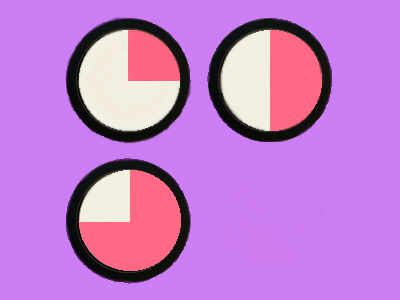
Ask the AI Tutor
Need help with Year 2 Fractions - Counting Up to 10? Ask our AI Tutor!
AI Tutor - Lucy
Connecting with Tutor...
Please wait while we establish connection

1⁄4, 1⁄2, 3⁄4... what comes next in this sequence?
Year 2 Fractions - Counting Up to 10
Meet halves and quarters to ten. Use ten-frames, share fairly, and check by counting. Small numbers, big ideas, and lots of neat equal parts.
Question 1
Which two numbers are next in this sequence?
21⁄4, 21⁄2, 23⁄4
21⁄4, 21⁄2, 23⁄4
3, 31⁄2
33⁄4, 4
24⁄4, 3
3, 31⁄4
Adding a quarter to 23?4 makes 3, and then adding another quarter makes 31?4
Question 2
What is wrong with this sequence:
31⁄4, 32⁄4, 31⁄2, 33⁄4
31⁄4, 32⁄4, 31⁄2, 33⁄4
33⁄4 is too large for the sequence
31⁄4 is in the wrong place
32⁄4 is the same as 31⁄2
There aren't enough numbers in the sequence
32?4 has exactly the same value as 31?2 so shouldn't be there!
Question 3
What is happening in this sequence:
21⁄4, 22⁄4, 23⁄4, 3
21⁄4, 22⁄4, 23⁄4, 3
The numbers increase by 2⁄4 each time
The numbers increase by 1⁄2 each time
The numbers increase by 1⁄3 each time
The numbers increase by 1⁄4 each time
Each number is 1?4 more than the one before it
Question 4
Which two numbers are missing:
3, ___, 31⁄2, 33⁄4, 4, ___
3, ___, 31⁄2, 33⁄4, 4, ___
32⁄4 and 41⁄2
31⁄4 and 4
41⁄4 and 51⁄4
31⁄4 and 41⁄4
Each number is one quarter more than the one before it
Question 5
What comes next: 2⁄4, 3⁄4, 1
4⁄4
11⁄4
2 1⁄4
1 3⁄4
Counting up in quarters means that after 1, it will be 1 + 1?4 more
Question 6
Which three numbers come next?
31⁄2, 33⁄4, 4
31⁄2, 33⁄4, 4
4, 5, 6
43⁄4, 5, 53⁄4
42⁄4, 43⁄4, 4 4⁄4
41⁄4, 41⁄2, 43⁄4
The numbers are one quarter more each time
Question 7
Which two numbers come next in this sequence?
41⁄2, 5, 51⁄2, 6
41⁄2, 5, 51⁄2, 6
52⁄2, 6
61⁄2, 7
6, 7
61⁄4, 7
The sequence is going up by 1?2 each time
Question 8
What comes next: 1, 11⁄2, 2, 21⁄2
2
31⁄2
3
22⁄2
Adding another half to 21?2 results in 3
Question 9
Which two numbers are missing:
51⁄2, ___, 61⁄2, ___
51⁄2, ___, 61⁄2, ___
6 and 7
5 and 6
7 and 8
6 and 9
The sequence is going up in halves
Question 10
What are the next three numbers in this sequence?
7, 71⁄4, 71⁄2
7, 71⁄4, 71⁄2
73⁄4, 74⁄4, 75⁄4
73⁄4, 8, 81⁄4
7, 81⁄2, 9
74⁄4, 8, 9
The sequence is going up by a quarter each time. 71?2 is the same as 72?4
**Unlimited Quizzes Await You! 🚀**
Hey there, quiz champ! 🌟 You've already tackled today's free questions.
Ready for more?
Ready for more?
🔓 Unlock UNLIMITED Quizzes and challenge yourself every day. But that's
not all...
not all...
🔥 As a Subscriber you can join our thrilling "Daily Streak" against other
quizzers. Try to win a coveted spot on our Hall of Fame Page.
quizzers. Try to win a coveted spot on our Hall of Fame Page.
Don't miss out! Join us now and keep the fun rolling. 🎉
**Unlimited Quizzes Await You! 🚀**
Hey there, quiz champ! 🌟 You've already tackled today's free questions. Ready for more?
🔓 Unlock UNLIMITED Quizzes and challenge yourself every day. But that's not all...
🔥 As a Subscriber you can join our thrilling "Daily Streak" against other quizzers. Try to win a coveted spot on our Hall of Fame Page.
Don't miss out! Join us now and keep the fun rolling. 🎉






